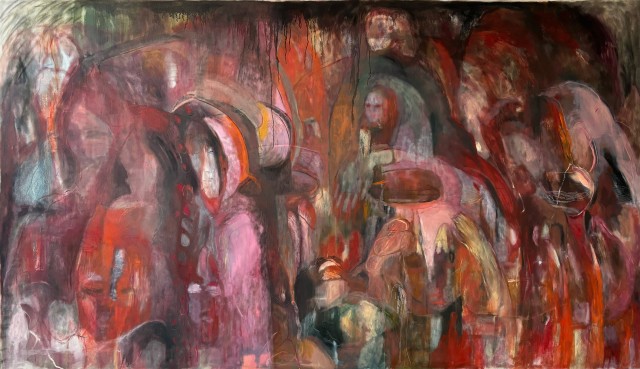Is there any solace in the certainty that each day will end and a new one begins? That time always moves, whether linearly or in some constellation of directions. Or is this temporal consciousness a stifling reality, a constant grappling with the recognition that while the days may progress, the circumstances that structure them do not. So many grasp for some comfort in routine, minuscule opportunities to garner control or trick the mind into perceiving that this is even feasible. It is too heavy to bear the understanding that we negotiate worlds in which our individual existence is inconsequential, and so we aspire for moments and methods of stability. Insidious violent conditions saturate everyday life, exceeding the destruction one imagines is realizable by human actions. Trauma interlaced into the experience of living, stretching the limits of the body and psyche.
These tensions permeate Nour Malas’ exhibition Evil is Banal, traversing the physical and emotional landscapes of worlds increasingly marked more by pervasive violence than by its absence. Through Malas’ gestures layering oil paint on canvas, a meditative eye catches glimpses of identifiable images. She blurs abstraction with the presence of figures, vessels for the viewer to deploy their own projections. There is a levity of humor that characterizes her practice and extends beyond the initial impulse to describe the works as haunting. A smirk peers through the density of “Green baby monster,” amidst the melding crowd, as a reminder of what can be avoided and stirred up in chaos. Satire has always existed in the company of evil.
Malas draws on a color palette that emerges from her own daily regimen, grounded in intimate attempts at cultivating a sense of security through repetition. Creating oxidized tones, the vibrancy of red ochre, cadmium orange, and vermilion is juxtaposed with the shadowy, complementary intermixture of greenish umber and raw sienna. She associates these colors both to the inner contours of the body as well as responses of alarm or anxiety, manifestations of psycho-social reactions. “Ribcage” and “Millions of Years of Reproduction and Death Designed the Human Body” exude a cavernous expanse that manipulates depth and obscurity. Through her compositional balance, though the canvas is full, it is not burdened. There is a deep physicality to her gesture and mark making, a downward, curved motion appears often as she translates the extension of the body onto the surface. She embraces the force of the brush in the works on canvas, trusting her layering process to hold the intensity of the marks. There is always risk in surrender, a release into the ritual rather than a fixation on the outcome.
The material quality of linen brings forth a delicate vulnerability that exposes each mark. Acutely aware of the woven fibers, she creates a co-presence with the fabric’s natural pigment and the colors applied to its surface. Malas narrates a slow intention, stimulated by linen’s insistent corporeality. In “lose, lose,” two graphite marks stretch to the edge of the frame in the upper right corner. Their buoyancy is a central gesture in dialogue with the weight of the darker tones in the piece. The intricacy of Malas’ mark making is emphasized in the works on linen, breathing and accentuated alongside expanded negative space that does not signal absence but contemplation.
Political philosopher Hannah Arendt reckons with the utter ordinariness of Nazi lieutenant Adolf Eichmann, one of the major orchestrators of the Holocaust, while witnessing his 1961 trial. She articulates the “banality of evil,” to underscore that the unconscionable acts of genocide were not perpetrated by exceptional individuals, but part of a wider belief that estimated some human lives as disposable. We continue to witness this emboldened sentiment spread. In our conversation, Malas reflects on her family’s circuitous route of migration. Displacement upheaves feelings of belonging, scattering communities into diaspora with the nebulous thought of return. This unsettling becomes one’s condition, not merely an effect. When home is an ambiguous place, the desire for consistency carries reassurance even as one remains aware of the cracks in this elusive safety.
In Evil is Banal, Malas beckons the viewer to enter their own subconscious. Our fragile selves wander in a world that so often feels overwhelming. Relinquishing herself into the process of painting, she loosens the constraints that anchor her life, allowing her gestures to be guided by intuition. Across several works, she pulls the viewer’s eyes to a horizon, a spatial orientation evident in “Boundless, Fabulous” that is imbued with conceptual possibility and arouses the mind to envision elsewhere. Nour Malas breaks open the container of emotions embedded into the mundane as notes on the unremarkable facets of self that should not be disregarded. An elongated spill, the self is made bare.
96

